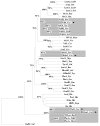Cereulide synthetase gene cluster from emetic Bacillus cereus: structure and location on a mega virulence plasmid related to Bacillus anthracis toxin plasmid pXO1
- PMID: 16512902
- PMCID: PMC1459170
- DOI: 10.1186/1471-2180-6-20
Cereulide synthetase gene cluster from emetic Bacillus cereus: structure and location on a mega virulence plasmid related to Bacillus anthracis toxin plasmid pXO1
Abstract
Background: Cereulide, a depsipeptide structurally related to valinomycin, is responsible for the emetic type of gastrointestinal disease caused by Bacillus cereus. Recently, it has been shown that this toxin is produced by a nonribosomal peptide synthetase (NRPS), but its exact genetic organization and biochemical synthesis is unknown.
Results: The complete sequence of the cereulide synthetase (ces) gene cluster, which encodes the enzymatic machinery required for the biosynthesis of cereulide, was dissected. The 24 kb ces gene cluster comprises 7 CDSs and includes, besides the typical NRPS genes like a phosphopantetheinyl transferase and two CDSs encoding enzyme modules for the activation and incorporation of monomers in the growing peptide chain, a CDS encoding a putative hydrolase in the upstream region and an ABC transporter in the downstream part. The enzyme modules responsible for incorporation of the hydroxyl acids showed an unusual structure while the modules responsible for the activation of the amino acids Ala and Val showed the typical domain organization of NRPS. The ces gene locus is flanked by genetic regions with high homology to virulence plasmids of B. cereus, Bacillus thuringiensis and Bacillus anthracis. PFGE and Southern hybridization showed that the ces genes are restricted to emetic B. cereus and indeed located on a 208 kb megaplasmid, which has high similarities to pXO1-like plasmids.
Conclusion: The ces gene cluster that is located on a pXO1-like virulence plasmid represents, beside the insecticidal and the anthrax toxins, a third type of B. cereus group toxins encoded on megaplasmids. The ces genes are restricted to emetic toxin producers, but pXO1-like plasmids are also present in emetic-like strains. These data might indicate the presence of an ancient plasmid in B. cereus which has acquired different virulence genes over time. Due to the unusual structure of the hydroxyl acid incorporating enzyme modules of Ces, substantial biochemical efforts will be required to dissect the complete biochemical pathway of cereulide synthesis.
Figures





Similar articles
-
Cereulide Synthetase Acquisition and Loss Events within the Evolutionary History of Group III Bacillus cereus Sensu Lato Facilitate the Transition between Emetic and Diarrheal Foodborne Pathogens.mBio. 2020 Aug 25;11(4):e01263-20. doi: 10.1128/mBio.01263-20. mBio. 2020. PMID: 32843545 Free PMC article.
-
Complete sequence analysis of novel plasmids from emetic and periodontal Bacillus cereus isolates reveals a common evolutionary history among the B. cereus-group plasmids, including Bacillus anthracis pXO1.J Bacteriol. 2007 Jan;189(1):52-64. doi: 10.1128/JB.01313-06. Epub 2006 Oct 13. J Bacteriol. 2007. PMID: 17041058 Free PMC article.
-
Identification of the main promoter directing cereulide biosynthesis in emetic Bacillus cereus and its application for real-time monitoring of ces gene expression in foods.Appl Environ Microbiol. 2010 Feb;76(4):1232-40. doi: 10.1128/AEM.02317-09. Epub 2009 Dec 28. Appl Environ Microbiol. 2010. PMID: 20038713 Free PMC article.
-
What sets Bacillus anthracis apart from other Bacillus species?Annu Rev Microbiol. 2009;63:451-76. doi: 10.1146/annurev.micro.091208.073255. Annu Rev Microbiol. 2009. PMID: 19514852 Review.
-
Food-bacteria interplay: pathometabolism of emetic Bacillus cereus.Front Microbiol. 2015 Jul 14;6:704. doi: 10.3389/fmicb.2015.00704. eCollection 2015. Front Microbiol. 2015. PMID: 26236290 Free PMC article. Review.
Cited by
-
Cereulide Synthetase Acquisition and Loss Events within the Evolutionary History of Group III Bacillus cereus Sensu Lato Facilitate the Transition between Emetic and Diarrheal Foodborne Pathogens.mBio. 2020 Aug 25;11(4):e01263-20. doi: 10.1128/mBio.01263-20. mBio. 2020. PMID: 32843545 Free PMC article.
-
Genetic Profile and Toxigenic Potential of Bacillus cereus Isolates from a Norwegian Ice Cream Production Plant.Foods. 2024 Sep 24;13(19):3029. doi: 10.3390/foods13193029. Foods. 2024. PMID: 39410065 Free PMC article.
-
Multiplex PCR for species-level identification of Bacillus anthracis and detection of pXO1, pXO2, and related plasmids.Health Secur. 2015 Mar-Apr;13(2):122-9. doi: 10.1089/hs.2014.0056. Epub 2015 Mar 20. Health Secur. 2015. PMID: 25813976 Free PMC article.
-
Occurrence of D-amino acids in natural products.Nat Prod Bioprospect. 2023 Nov 7;13(1):47. doi: 10.1007/s13659-023-00412-0. Nat Prod Bioprospect. 2023. PMID: 37932633 Free PMC article. Review.
-
Pathogenicity and Genomic Characterization of a Novel Genospecies, Bacillus shihchuchen, of the Bacillus cereus Group Isolated from Chinese Softshell Turtle (Pelodiscus sinensis).Int J Mol Sci. 2023 Jun 1;24(11):9636. doi: 10.3390/ijms24119636. Int J Mol Sci. 2023. PMID: 37298593 Free PMC article.
References
-
- Turnbull PC. Introduction: anthrax history, disease and ecology. Curr Top Microbiol Immunol. 2002;271:1–19. - PubMed
-
- Aronson AI, Shai Y. Why Bacillus thuringiensis insecticidal toxins are so effective: unique features of their mode of action. FEMS Microbiol Lett. 2001;195:1–8. - PubMed
-
- Granum PE. Bacillus cereus. In: Doyle MP, editor. Food Microbiology: Fundamentals and Frontiers. 2nd. Washington D.C. , ASM Press; 2001. pp. 373–381.
Publication types
MeSH terms
Substances
LinkOut - more resources
Full Text Sources
Other Literature Sources

